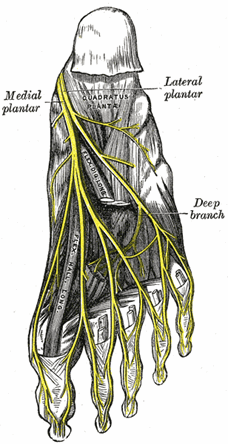Morton’s Neuroma
Morton's Neuroma

Morton’s Neuroma is a common and frustrating cause of forefoot pain within the population. The condition commonly results from a thickening or compression of the nerves between the bones of the forefoot (intermetatarsal space). This compression can result in a range of symptoms including sharp pains in the ball of the foot as well as burning, numbness and other abnormal neurological symptoms that can shoot up into the toes. The cause of the pain is not currently fully understood however some suggest that it may be caused by genetics and/or long term irritation of the nerve. Morton’s Neuroma is typically diagnosed clinically based on the signs and symptoms and can often be assisted with imaging such as ultrasound to exclude other common causes of forefoot pain, such as bursitis, plantar plate injuries, stress fractures and/or Osteo arthritis. Treatment is focused on offloading the compression of the nerve, which can be achieved by a number of different treatments including orthotics, padding and footwear changes as well as injection therapy. It is essential that the exact cause of the pain be identified as incorrect management options will prolong pain and, in some cases, exacerbate the severity of the injury.

Morton’s Neuroma is a common and frustrating cause of forefoot pain within the population. The condition commonly results from a thickening or compression of the nerves between the bones of the forefoot (intermetatarsal space). This compression can result in a range of symptoms including sharp pains in the ball of the foot as well as burning, numbness and other abnormal neurological symptoms that can shoot up into the toes. The cause of the pain is not currently fully understood however some suggest that it may be caused by genetics and/or long term irritation of the nerve. Morton’s Neuroma is typically diagnosed clinically based on the signs and symptoms and can often be assisted with imaging such as ultrasound to exclude other common causes of forefoot pain,

such as bursitis, plantar plate injuries, stress fractures and/or Osteo arthritis. Treatment is focused on offloading the compression of the nerve, which can be achieved by a number of different treatments including orthotics, padding and footwear changes as well as injection therapy. It is essential that the exact cause of the pain be identified as incorrect management options will prolong pain and, in some cases, exacerbate the severity of the injury.
Why has this happened?
The exact cause is not fully understood. A neuroma most often affects women over 50 years of age and aggravated by tight or high-heeled shoes. Faulty foot mechanics is thought to play a role. The condition seems to occur in response to irritation, pressure or injury to one of the nerves that lead to your toes. The neuroma is part of your body’s response to the irritation or injury. In some cases, Morton’s neuroma may result from abnormal movement of your foot, caused by bunions, hammertoes, flatfeet or excessive flexibility.
Do I have to have an operation?
Pads, rest, ice, and anti-inflammatory medication can help improve comfort. Wide shoes with foot orthoses and cortisone injections may resolve the pain in some people. If the neuroma is small in size a course of 5-6 injections of local anasthesetic around the neuroma can also be helpful. No long-term studies are available. However, surgery is recommended if these measures are ineffective and the problem continues to interfere with your quality of life.
What will the operation involve?
The operation involves removing the enlarged nerve by a cut made on the top of the foot. The deep transverse metatarsal ligament suspected of causing some of the constriction above the nerve is released. The thickened nerve is then isolated from the surrounding tissue and cut where the nerve trunk appears normal again. An inflamed intermetatarsal bursa is often present and this is also removed. The specimen is sent for a pathology examination.
How successful is the operation?
This operation (neurectomy) by a dorsal approach has shown good to excellent patient satisfaction rates (78-84%) in two good studies (1,2). The Coughlin & Pinsonneault study is a long term follow up after 11 years.
Are there any risks associated with the operation?
- Infection (smoking increases by 16X)
- Stump neuroma can occur when little sproutlets of nerve from the cut end of the nerve starts to grow again. These sproutlets can grow into a ball that hurts like (or more than) the original neuroma and this requires further surgery to rectify.
- Wound problems (slow to heal)
- Scar sensitivity
- Nerve Injury (Nerves can be bruised which resolves but you can be left with permanent numbness)
- CRPS = Complex Regional Pain Syndrome (Rare <1%)
- Deep Vein thrombosis (clot in deep vein in the legs)
The underneath of the foot can remain tender for about 3-4 months after surgery. This is likely to resolve on its own without treatment. An orthotic will also help.
References:
To make an appointment click here:

